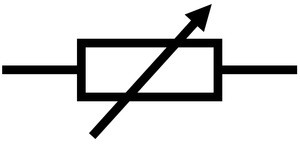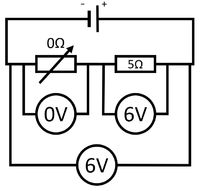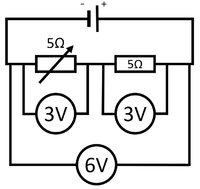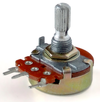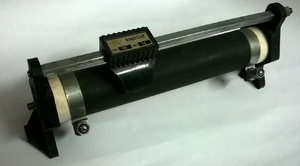Variable Resistor
Contents
Key Stage 4
Meaning
A variable resistor is a resistor which can have its resistance changed.
About Variable Resistors
- A variable resistor can be used to control the current passing through a circuit. If the potential difference is constant then the current decreases as the resistance of the variable resistor increases.
- A variable resistor can be used to control the potential difference of another component in series with it. If the resistance of the variable resistor is increased the potential difference across other components will decrease.
| In this circuit the variable resistor has a resistance of 0Ω.
The potential difference across the fixed resistor is 6V. The current through this circuit is given by\[I = \frac{V}{R}\] \(I = \frac{6}{5}\) \(I = 1.2A\) |
In this circuit the variable resistor has the same resistance as the fixed resistor (5Ω).
The potential difference across the fixed resistor is 3V. The current through this circuit is given by\[I = \frac{V}{R}\] \(I = \frac{6}{10}\) \(I = 0.6A\) |
In this circuit the variable resistor has twice the resistance of the fixed resistor (10Ω).
The potential difference across the fixed resistor is 2V. The current through this circuit is given by\[I = \frac{V}{R}\] \(I = \frac{6}{15}\) \(I = 0.4A\) |
Examples
| This variable resistor can be turned to change the resistance. | This variable resistor is known as a Rheostat. The slider can be moved to change resistance. |
References
AQA
- Variable resistor, page 52, GCSE Physics; Student Book, Collins, AQA
- Variable resistors, circuit symbol, page 38, GCSE Physics, Hodder, AQA
- Variable resistors, pages 293, 296, GCSE Combined Science Trilogy 1, Hodder, AQA
- Variable resistors, pages 52-53, GCSE Physics; Third Edition, Oxford University Press, AQA
